Vazhakku Enn 18/9 – A Visual Essay
by PK Senthil
The recent film from Balaji Sakthivel Vazhaku En 18/9 is a visual tour-de-force. This film has received universal praise from everywhere. Very rarely do we come across a movie in India that can truly be called "Cinema". The following is my attempt to exemplify what makes this film so special. For a film industry whose roots are tied to Drama, Theater and Music this film marks the real progression towards Cinema as a genuine medium. Its very rare to find such a “visual” masterpiece of cinema. Hence, I have decided to take the path of a “visual essay” instead of the tradition words to describe the nuances in the movie.
*** Spoiler Galore ***
1. Hidden Clues - Peek into the future
The movie pretty much starts with an homage to Godard and his famous saying -- “A story should have a beginning, a middle, and an end... but not necessarily in that order.”
Of course there are now several movies in the last 10 years that has adopted this “formula”. What is unique about its usage in this film is how the mystery of "what's going to happen" is revealed by shots throughout the movie and not just at the start. The following screen-grab is right at start of the movie,
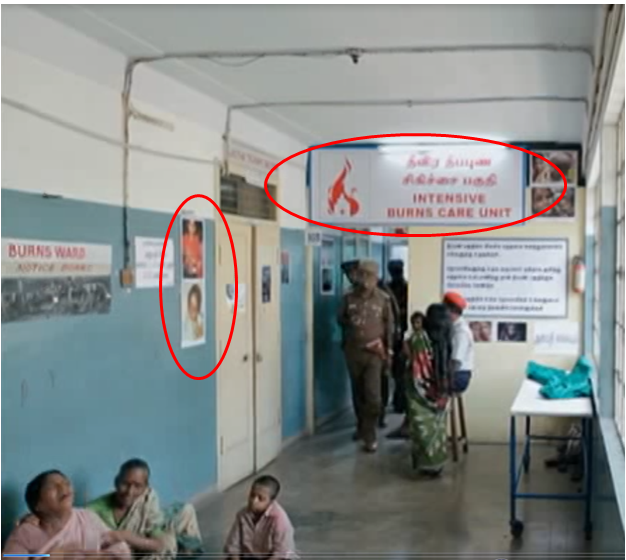
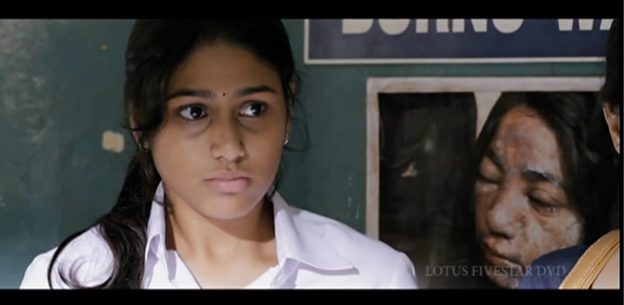

The movie even goes an extra step to further indicate to the audience the idea of an impending "Acid Attack" - there are 2 such instances where this is seen. The first one is introduction of Jyothi and Velu - we literally see him throwing Water at her.

The Second one is when the other pair is seen discussing about Acids
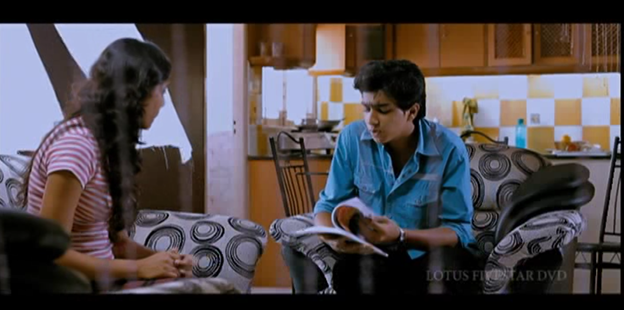
2. Life as a Prison
In addition to both the above shots premonition-ing an impending "Acid Attack", these shots also highlight how all characters in the movie appear imprisoned right from start. Here is Velu's introduction shown quite literally as being "Imprisoned". The Movie appears to take a stance to indicate "Life as a Prison" . The following perhaps shows the audience (us) in prison watching this cinema. Its wickedly ironic the Ganja dealer wears a T-Shirt which says "Anyone, Anywhere, Anytime".
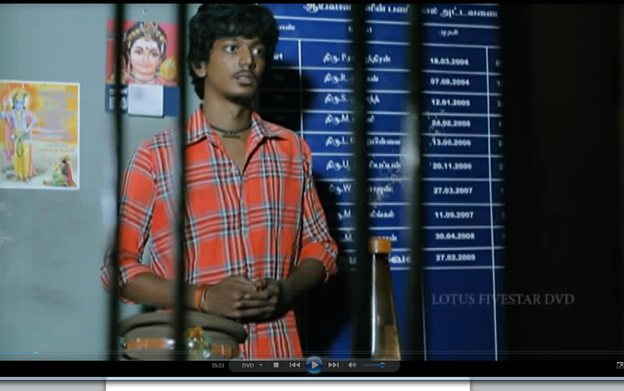
Jayalakshmi also imprisoned (and as an inside joke we even see a picture of Swamin Nithyanandha in the background). Even the Inspector appears Imprisoned in several shots in the Movie.

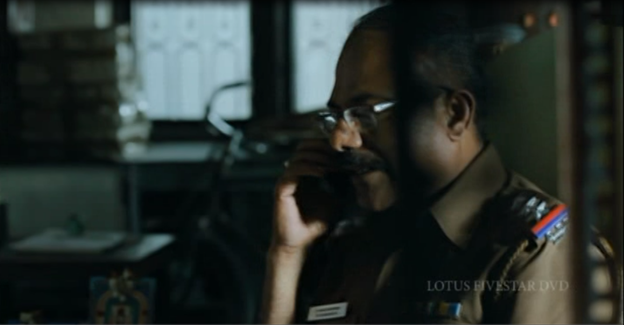
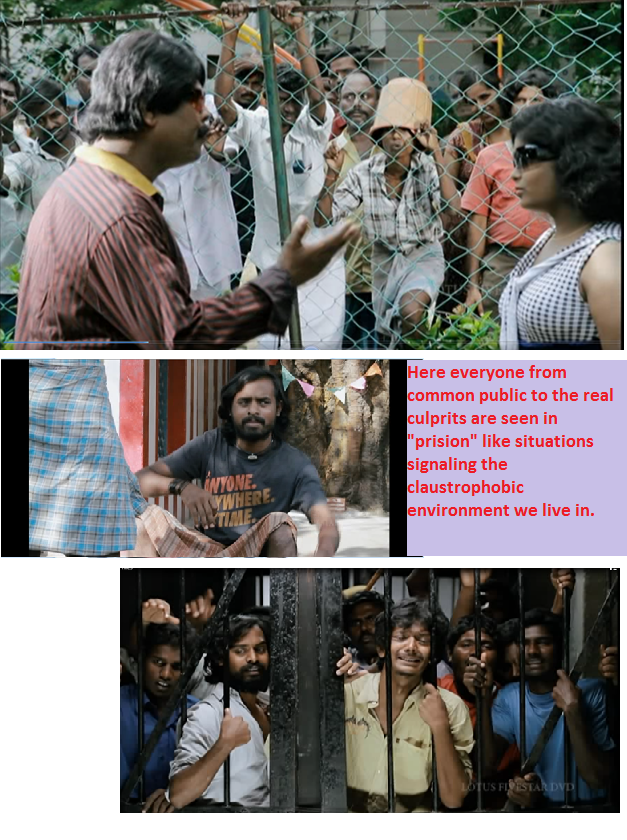
3. Mirror Mirror on the Wall
We should also highlight the several Mirror shots that the director employs through out the movie. Now Mirror shots are very popular among directors. Though it is very difficult to judge what the directors intention is on using Mirror shots, I would like to quote Douglas Sirk about how he viewed Mirrors in his framing.
"The mirror is the imitation of life. What is interesting about a mirror is that it does not show yourself as you are, it shows you your own opposite."
With this lets look at how some of the Mirror shots build characters through out the film. The first sets of shots are all of Either Aarthi or Dinesh

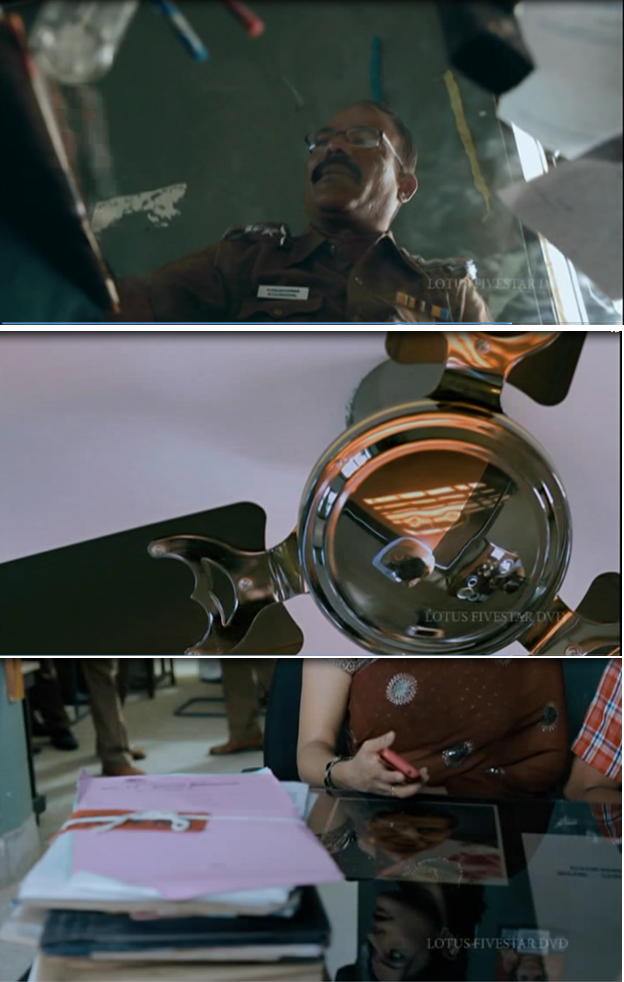

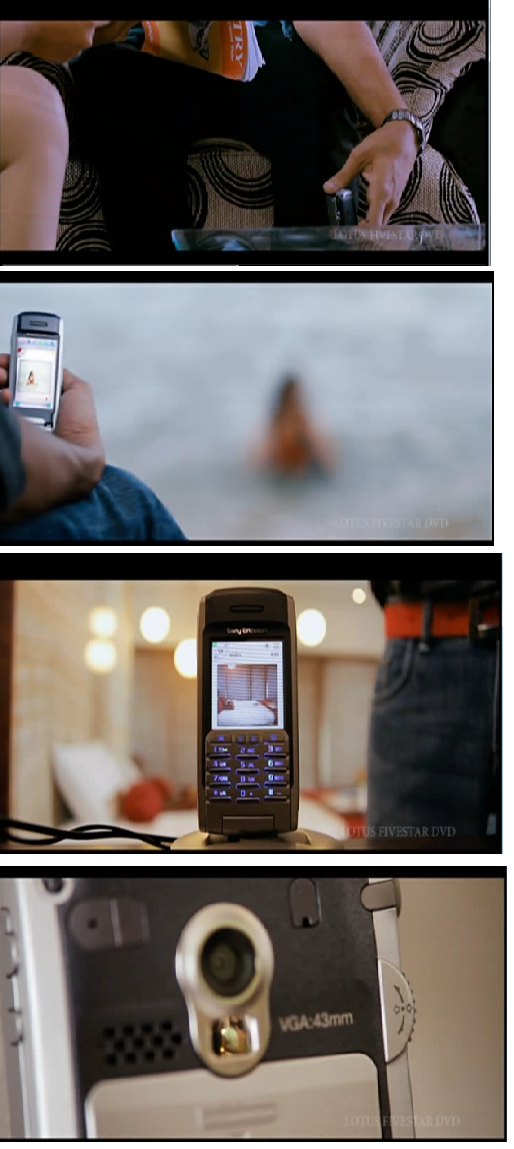
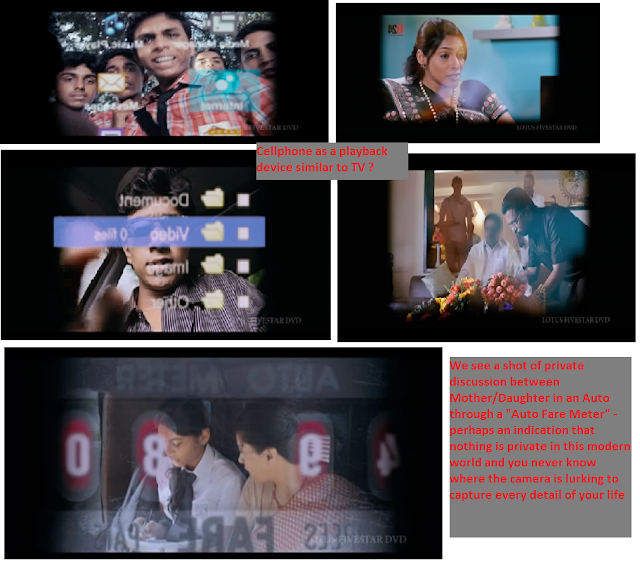
Cellphone as recording device too,
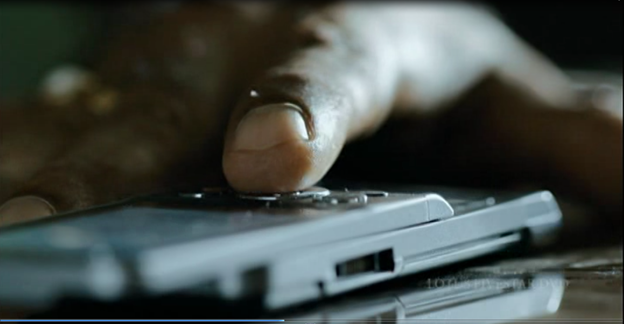
5. Building Space by Sculpting in Time
Cinema is often compared with Architecture to highlight how the director chooses to carefully construct scenes both in terms of space and time. This is done beautifully without messing with the audience's patience (or intelligence). The movie as a narrative technique mixes up the chronology of how the scenes unfolds on screen. Though this is a common technique used by several modern directors what the director has done is kept a structural rigidity on how he uses space. We notice once the action kicks in characters are seen moving about in a very familar neighborhood and by repeating this again and again he makes sure the temporally dis-oriented audience is atleast rooted spatially. This also has the additional effect of building a "tension" as the audience are kept in the dark on how all this is going to play over in time.

6. Rich/Poor divide
One of the strong criticism of 18/9 is how cliche ridden the Rich/Poor divide appears in the film. I don't see anything wrong with it especially since the "rich poor divide formula" is used to construct a socio-economic view point with a political tinge. Here the foundation is strongly based on Marxism/Leninism. What is even more interesting is that this appears in the Velu's "Dream sequence" perhaps signalling the ideal yet seemingly unreal principles.

7. Different Aspect Ratio for Rich vs Poor
Using different Aspect Ratio when filming "Rich Vs Poor" - Digital Vs Film
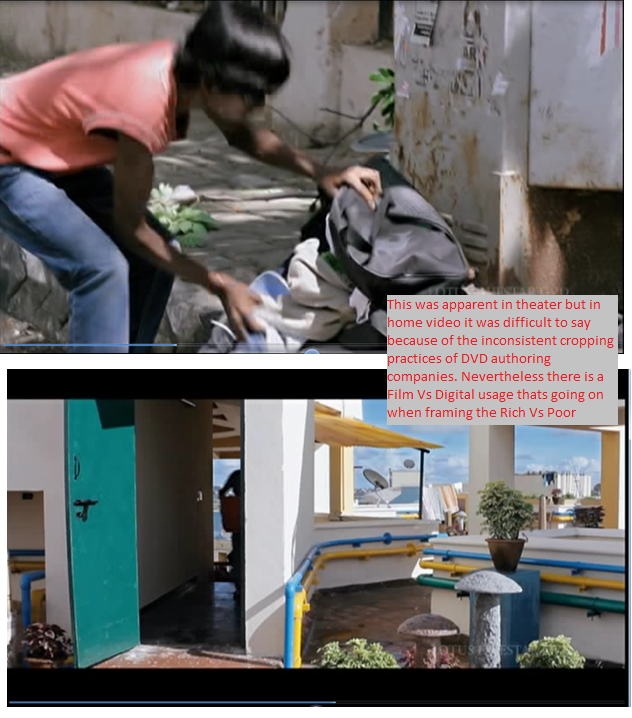
8. Impotent God Symbols
If there is a need for further proof we could look at some of the impotent religious symbols that forms part of the movie landscape. In this movie (and what seems to be a trend these days) Chance seems to take precedence over Fate and hence these religious symbols provide nothing more than a Placebo effect. There is no "Hand of God" and by end of the movie the audience are convinced of the same.
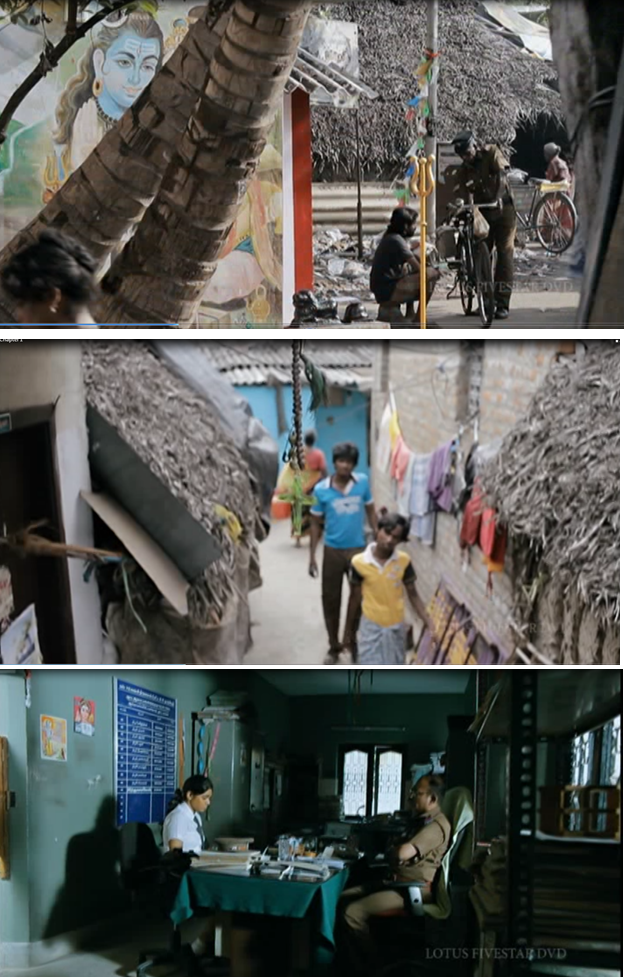

9. Teenage Peer Pressure
This is one of the few movies in Tamil cinema (perhaps even Indian cinema) where teenagers are not inflated into "Mass Heroes". These are kids with real problems irrespective of the social and economic background they come from. I strongly feel Balaji Sakthivel has pointed the camera at them in the most non-exploitative way possible. The way "peer pressure" is shown in the film clicks at multiple levels in terms group dynamics especially when at a particular age you are not sure what is "right and wrong" and your aim is "acceptance within a group". The following screen grabs highlights the same.

10. Why is the inspector listening to the story?
If this film is treated as "realistic cinema" then there is no apparent reason for the inspector to listen to the poor kids story as this is an open/shut case (other than for narrative reasons). To explain this my focus turns to two main characters in this film - The Inspector and Chinaswamy. Lets look at the inspector first...., I feel here the inspector represents the consiousness of the director. This is shown by the uncanny resemblance of both director and the inspector. Also part of the directors name ("Sakthivel") is also part of the inspectors name (Kumaravel) .

In addition there are further clues towards the end of the Movie where he instrucuts Velu to respond to the judge with the right modulation. Something very similar to how he would “direct his actors”

11. Life in 24 frames per second
What is interesting is when Chinaswamy arrives and departs . He arrives @24:24 and leaves around 48:24 - perhaps a reference to 24 frames per second(fps)

12. Contrasting Love
Balaji Sakthivel seems to contrast this with Dinesh/Aarthi in a couple of shots at the beach with a slipper pair - Velu/Jytohi are together while Dinesh/Aarthi are seperate.

13. Conclusion
This could have easily been made as a "Poor Boy in Love with Rich Girl" type Movie. Vazhakku Enn 18/9's canvas is much bigger and much deeper in the topics that it wants to touch on. I think in the modern world this film is a sharp critique on capitalism using century old socio-economic-political point of view. This could refer to the loss of agriculture land, child labour, families splitting up going in search of jobs, communication break down within families, increasing rich/poor divide among several other things. This Movie is not really about love (though it ties all these together). But, it is more about the "loss".
To read Senthil PK's brilliant article from source - Still Breathing, Thoughts on Films
Contact: Editor@MovieCrow.com.

